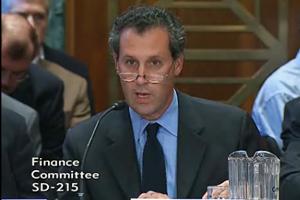On Monday, Sept. 8, Amherst President Anthony W. Marx presented testimony in Washington, D.C. at a roundtable examining college endowments called by U.S. Sen. Charles Grassley (R-Iowa) and U.S. Rep. Peter Welch (D-VT).
At a panel titled “Are Mandatory Payouts Beneficial?” Marx summarized the college’s efforts to ensure access and enhance affordability and argued that a spend rate requirement would not achieve much social benefit, while bringing real risks. The text of his remarks follows. (Watch him deliver his testimony, which begins at 185:15.)
 Amherst President Anthony W. Marx speaking at a Congressional roundtable Sept. 8 |
I share the concern that middle- and low-income families face about paying for college. And I appreciate the interest that Sen. Grassley, Congressman Welch and the public as a whole have in not only the spending patterns of colleges and universities but in the cause of educating our young people. I am truly pleased to join this conversation.
Allow me to say from the start that I agree with Sen. Grassley that the sky will not fall if we spend more from our endowment, as we are now already doing as a buffer against harder times. Still, I worry that even slightly-less-well-endowed institutions might be hurt by a spending minimum during an economic downturn. More importantly, I do not believe this mandate will address the concern about affordable quality education.
In the larger educational system, we see structural inequalities and insufficiencies that keep all students from demonstrating and pursuing their abilities. Graduation from high schools in America is decreasing, just when we need more skilled labor. Meanwhile, government appropriations for public universities and community colleges have decreased.
For those reasons, I think the debate about 5 percent raises deeper questions. What is it we are trying to achieve? The question is not "How much money do we have?" but "What should we be using that money for?" At Amherst, the answer is quite simple: We have a responsibility to spend our endowment on access, quality instruction and service to society—to its economy and democracy. We are committed to doing more toward that goal, with or without a 5 percent spend rule.
We are all concerned that middle- and lower-income families are fearful of our sticker price and are underrepresented at top colleges and universities. I agree and have been hard at work improving economic diversity and access to Amherst. For example, last summer, we replaced loans with grants for all students receiving financial aid, providing the opportunity for students to graduate debt-free and free to make career choices accordingly. At Amherst, almost 20 percent of our American students are now low-income, Pell-eligible. And we have accomplished this while maintaining the highest standards of selectivity.
I welcome innovative proposals that would further ensure college access to low-income and to middle-class students. For instance, as at Amherst, top colleges and universities should fund programs that deploy their own students to offer tutoring and college advice to rural and urban high school students.
The truth is that a spending floor will not achieve much social benefit overall, while bringing real risks. If current economic conditions prevail, many endowments will be lucky to generate single-digit returns. Negative returns are more likely. That will cause our spending rates to drift well north of 5 percent anyway, while increasing aid as needed for more squeezed families and eating into our endowment, since parental payments already make up less than 40% of our revenues. In recent flush years, a slightly lower spend rate has helped provide capital for the inevitable lean years. Such leaner years are now here, thanks to increases in costs such as energy, food and health care insurance and decreases in endowment returns. More such challenges likely lie ahead. We are not foundations that can reduce grant-making; we cannot close the English department or biology department during a downturn.
Still, I do share public concern about the affordability of college. Amherst (and Princeton) have recently had among the lowest rates of tuition increase among our peers. Still, the price tag seems too high. We scare off students who do not know that less than half our students pay the full price, that even those who do pay full price are significantly subsidized by our endowment and that many pay nothing at all.
There is a conundrum here: While students who pay the full sticker price do, in effect, help subsidize those who cannot, that price tag also discourages those who most need aid from applying to our nation's best colleges and universities. Mandating a minimum endowment spend rate won't change this. Instead, the wealthiest institutions may feel pressed to no longer charge any tuition to the wealthiest students. What is the social benefit in that exactly?
With these caveats in mind, I welcome the continuing discussion of more productive ways to ensure access to quality education at the K-12 level and above, and not just at the top colleges and universities.